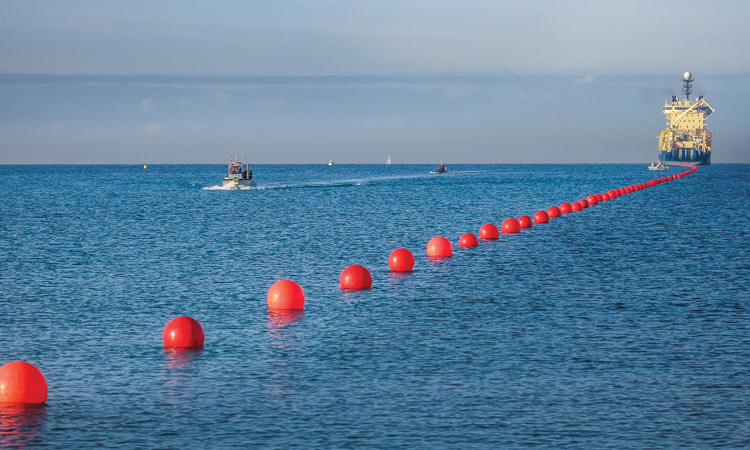 Network operators are laying more submarine cables with ever-higher capacities to support demand for data services. [Alcatel Submarine Systems / Nokia]
Network operators are laying more submarine cables with ever-higher capacities to support demand for data services. [Alcatel Submarine Systems / Nokia]
The world’s growing reliance on mobile and digital technologies is driving a seemingly insatiable demand for data. The spread of streaming services, the advent of 5G mobile networks and the rapid rise of video calling and virtual work during the COVID-19 pandemic boosted global internet usage by almost 30% per year between 2017 and 2021.
That trend shows no sign of slowing down, with new applications and services capturing attention and millions more people becoming connected to the internet every year. According to the Ericsson Mobility Report, the amount of data consumed by the world’s population will more than triple over the next five years, extending beyond 900 exabytes per month by 2027. (An exabyte is 1018 bytes, or a billion gigabytes.)
Network operators are responding to that surging demand by accelerating plans to add capacity to their infrastructure. The most tangible sign is in the access networks, with dedicated fiber connections now reaching out to homes and businesses to satisfy their increasing dependence on video platforms and cloud computing. But the urgent need for extra bandwidth also extends to the submarine optical cables that provide the crucial connections between continents. These underwater links—which combine ultrafast data transfer with the security and reliability needed to underpin such critical infrastructure—now carry 99% of the world’s telecommunications traffic.
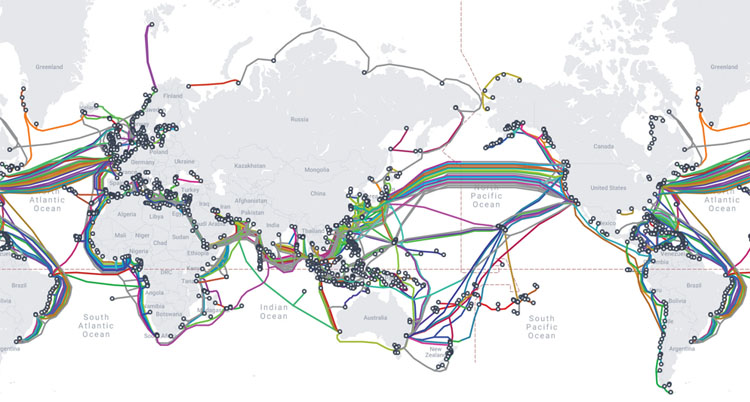 Global Links: The world’s oceans are home to more than 1.3 million km of optical fiber that provides crucial communications links all over the world. [Source: TeleGeography Submarine Cable Map, updated 10 January 2023]
Global Links: The world’s oceans are home to more than 1.3 million km of optical fiber that provides crucial communications links all over the world. [Source: TeleGeography Submarine Cable Map, updated 10 January 2023]
Submarine installations back on the rise
After a lull in activity around a decade ago, the last few years have seen a rapid uptick in installations of submarine cables across all major routes. Most new deployments are being funded by the likes of Google, Amazon, Microsoft and Meta, which together now account for around two-thirds of all internet traffic—and a jaw-dropping 90% on the busiest trans-Atlantic links. The industry analyst TeleGeography estimates that more than US$10 billion worth of new subsea cables will enter service between 2022 and 2024, adding to new installations over the previous five years with a combined price tag of US$9.2 billion. Demand on subsea links is now expected to increase at a compound annual rate of 30%–50% between 2021 and 2028, with the most rapid growth expected on routes across the Pacific Ocean and between Europe and Africa.
After a lull in activity around a decade ago, the last few years have seen a rapid uptick in installations of submarine cables across all major routes.
With each new deployment costing hundreds of millions of US dollars, submarine cable systems need to be designed with longevity in mind. That has driven intense technical innovation to send more information over each subsea link, with capacities rising from a few hundred gigabits per second (Gbps) in the 1990s to 250 terabits per second (Tbps) for the fattest pipe now in service—Google Cloud’s Dunant cable, which in 2021 connected Virginia Beach in the United States with Saint Hillaire in France.
Such capacity increases have generally been achieved by ongoing advances in fiber and transmission technologies that have increased the amount of data that can be sent through each fiber pair. But Dunant marked a change in strategy. Rather than maximizing the capacity on each optical channel, Google worked with its technology partner SubCom to deploy the first long-distance subsea cable to support 12 separate fiber pairs. Compared with the previous state-of-the-art (the MAREA link, with its eight optical channels), Dunant delivered a 40% increase in capacity.
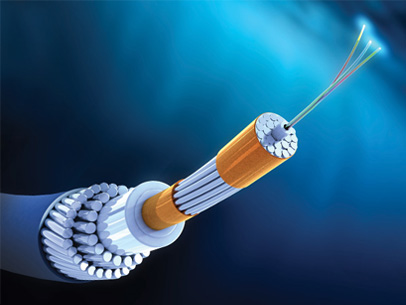 Designed for life: A submarine cable must be engineered to survive the underwater environment for several decades, while also providing sufficient power to maximize the amount of data that can be sent through each fiber pair. A copper layer is used for electrical conductivity, while steel cladding strengthens the structure. [Getty Images]
Designed for life: A submarine cable must be engineered to survive the underwater environment for several decades, while also providing sufficient power to maximize the amount of data that can be sent through each fiber pair. A copper layer is used for electrical conductivity, while steel cladding strengthens the structure. [Getty Images]
Different by design
Adding more fiber pairs might seem like an obvious solution, but in practice it demands a complete rethink of the system design. The capacity gains over the last decade or so have largely been achieved through so-called coherent transmission technologies, which have boosted the bandwidth even of pre-existing underwater infrastructure by upgrading the equipment at the ends of the cables. Combined with advances in digital signal processing, coherent technologies have made it possible to send and receive the complete optical signal rather than just the beam intensity. That, in turn, allows more information to be encoded into the optical field and opens up the light’s polarization as an additional data-carrying resource. As a result, systems optimized to work with these techniques have delivered a tenfold capacity boost since 2010.
Packing more data into individual fiber pairs, however, also requires that more power be supplied to each optical channel. And for subsea links, that power can only be injected at either end, with periodic repeaters used to maintain the signal strength over intercontinental distances.
The MAREA cable, for example, which in many ways represents the pinnacle of what can be achieved with coherent technologies, exploits high-power amplifiers in repeaters spaced just 56 km apart to maximize the bandwidth of each optical channel. But this approach can no longer be extended to support more fiber pairs. “The capacity we can achieve is limited by the power of the subsea cable,” explains Jeremie Renaudier, a lead researcher at Nokia Bell Labs in France. “We cannot increase the number of fiber pairs in these systems without having enough power to optimize the capacity and performance of each one.”
The Google/SubCom Dunant cable mitigates this power crunch by spreading the signal between different spatial dimensions, in this case additional fiber pairs. “Adding any new dimension makes it possible to share the power and increase the capacity,” comments Fatih Yaman, a senior researcher at NEC Labs in the United States. “First we used the wavelengths, and then we used the polarization. Space was the only dimension that was left.”
This technique, called space-division multiplexing (SDM), demands a new approach to amplification. Rather than having a pair of dedicated pump lasers for each fiber pair, an SDM system combines all the pumps together and then distributes the power to each optical channel. “This pump-sharing scheme reduces the power that is available for each fiber pair, which limits the maximum capacity that can be achieved on each transmission path,” explains Renaudier. “The system is sub-optimal on a per-fiber basis, but distributing the power increases the capacity of the whole cable.”
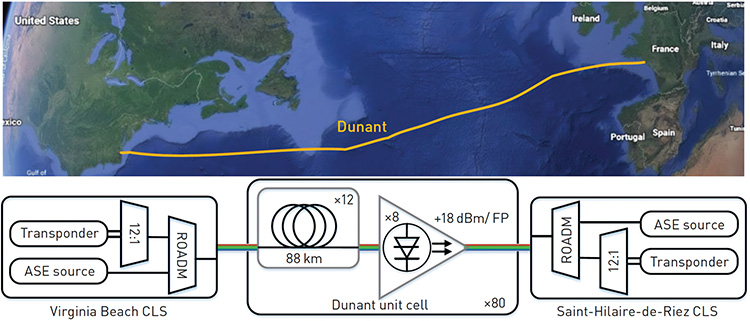 Route of the Dunant cable across the Atlantic (top) and a simplified schematic of a field trial reported at the 2022 OFC Conference (bottom). The cable, which employs space-division multiplexing (SDM), shares the repeater gain from eight optical pumps between 12 fiber pairs, using pump-sharing technology. In the trial, the Dunant cable achieved a near-40% capacity gain compared with the previous state of the art, the MAREA cable. [S. Varughese et al., OFC Conference 2022, paper M1F.2]
Route of the Dunant cable across the Atlantic (top) and a simplified schematic of a field trial reported at the 2022 OFC Conference (bottom). The cable, which employs space-division multiplexing (SDM), shares the repeater gain from eight optical pumps between 12 fiber pairs, using pump-sharing technology. In the trial, the Dunant cable achieved a near-40% capacity gain compared with the previous state of the art, the MAREA cable. [S. Varughese et al., OFC Conference 2022, paper M1F.2]
Power sharing offers other advantages too: it builds redundancy into the repeater units without needing to accommodate more amplifiers, and it reduces some of the impairments that start to degrade performance in high-power systems. Most important, though, the capacity of the cable multiplies as more fiber pairs are added. As a result, submarine links supporting 16 optical channels are already coming onstream, while two SDM systems capable of transmitting around 500 Tbps over 24 fiber pairs will soon enter service: the Confluence-1 system that will connect Miami with New York in 2023, and the EU-supported Medusa cable that is due to link Europe with North Africa the following year.
The demanding subsea environment places practical limits on the number of fiber pairs an SDM system can support.
End of the line
The demanding subsea environment, however, places practical limits on the number of fiber pairs an SDM system can support. At the most fundamental level, all of the individual fibers must fit into a standard-sized cable, which is typically 17 or 24 mm across. “It’s all about keeping the cost per bit as low as possible,” explains Yaman. “These cables are made from expensive materials, and increasing the cable diameter adds significantly more cost into the system. It also makes these very long cables much heavier when they are loaded onto a ship, which makes them more cumbersome to handle and install.”
Current research efforts thus focus on squeezing more fiber pairs inside a standard-sized cable, with the limit expected to be around 32 or possibly even 48. At the same time, cable companies like NEC are already preparing for a future when adding more fibers into the cable will no longer be economically viable.
“Something will have to give, and the most obvious way forward is multicore fiber,” says Yaman. “It is the only way to scale the number of optical channels without increasing the cable diameter.”
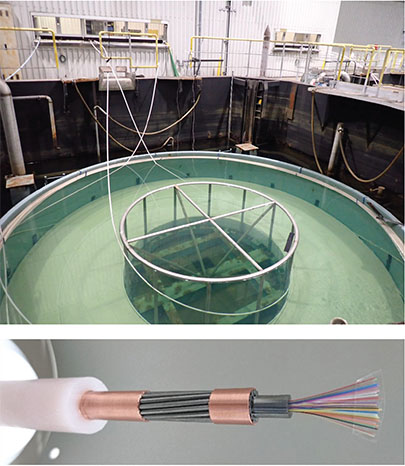 An experimental NEC submarine cable, incorporating 12 pairs of four-core fiber, is tested in a water tank. Engineers at NEC have demonstrated the feasibility of using multicore fiber in a commercial submarine cable that can withstand water pressures at depths of up to 8000 m. [Courtesy of NEC Labs]
An experimental NEC submarine cable, incorporating 12 pairs of four-core fiber, is tested in a water tank. Engineers at NEC have demonstrated the feasibility of using multicore fiber in a commercial submarine cable that can withstand water pressures at depths of up to 8000 m. [Courtesy of NEC Labs]
Indeed, NEC engineers have been working with fiber manufacturer Sumitomo Electric to develop a prototype submarine cable that incorporates 16 fiber pairs made from four-core fiber. In laboratory tests simulating real-world conditions, a 3000-km cable supporting 64 separate optical channels delivered a capacity of more than 1.7 petabits per second, and in 2021 NEC completed the first field trials of its prototype design. Exploiting standard cable technology that can withstand water depths of up to 8 km, the tests showed that the multicore fiber (MCF) maintained the required optical performance when integrated into a commercial submarine cable and submerged underwater.
The design exploits uncoupled MCF, which means that the cores operate independently of each other. In reality there is a small amount of crosstalk between the cores, while the components needed to interface the MCF with standard amplifiers also introduce some loss into the system. “When we design a multicore system we need to accept that loss as a reduction in capacity of each fiber, but at the cable level we gain so much more,” says Yaman. “We have been experimenting with MCF in the lab for 10 years or so, but this prototype is about as close as you can get to the real product.”
The trials suggest that an MCF solution could become technically feasible, but the economics remain uncertain. While MCF has the potential to deliver a significant reduction in the critical cost-per-bit figure, it is currently much more expensive to produce than standard single-mode fiber. “It’s not yet clear whether it’s a technical limitation or mainly a question of manufacturing volume,” says Yaman. “The issue for the industry right now is how fast and how far the costs come down as volumes increase.” Yaman also points out that MCF delivers significant savings in the material cost of cable manufacturing, which would make it competitive with standard fiber on a cost-per-core basis.
At the same time, the telecom industry is working hard to increase the power that can be supplied to a subsea cable, which will be needed for the SDM systems of the future to maintain a strong enough signal across growing numbers of optical channels. Improved sensing technologies are also being developed, which together with machine learning are providing network operators with more effective ways to manage the available capacity.
“Submarine systems are now being built with more fiber pairs and multiple landing points, which makes it essential to route the traffic as efficiently as possible,” says Renaudier. “We need advanced sensing techniques to detect any potential problems on the line and redirect the traffic if need be.”
Submarine sensors
Such sensing techniques can have other applications too. While the telecom industry is focusing on maximizing capacity and reducing the cost-per-bit, Earth scientists are hoping to unlock the optical information transmitted by subsea links to create a global network of environmental sensors. Any underwater disturbance can affect an optical signal as it travels along a fiber, which scientists have exploited to detect the vibrations caused by seismic and storm activity. Researchers in Norway have even shown that a submarine cable can pick up the sound of singing whales, offering an effective way to track their migration along the Norwegian coast.
Several different sensing modalities have been developed and tested in recent years. The Norwegian whale trackers exploited a technique called distributed acoustic sensing (DAS), which listens for underwater sounds by sending an optical pulse through a fiber and then analyzing the signal that is backscattered from different points along the cable. This DAS technique can pinpoint the source of the sound to within a few meters, although its range is limited to a few hundred kilometers from the shoreline.
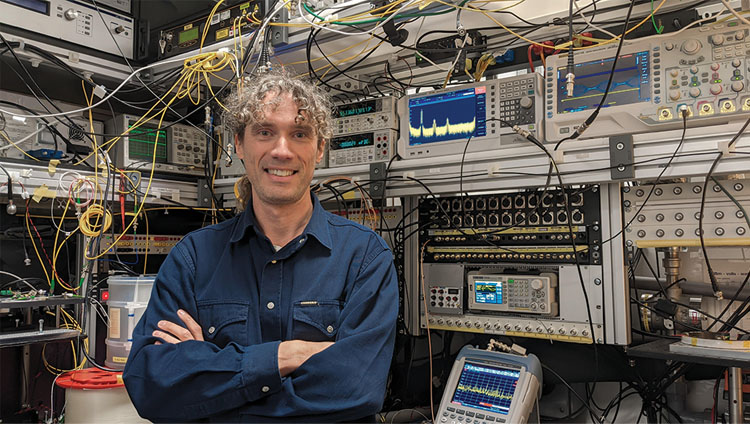 Giuseppe Marra and his team at the National Physical Laboratory, UK, have used the repeater technology installed in a subsea communications cable to create an array of environmental sensors spanning the Atlantic Ocean. [Courtesy of G. Marra]
Giuseppe Marra and his team at the National Physical Laboratory, UK, have used the repeater technology installed in a subsea communications cable to create an array of environmental sensors spanning the Atlantic Ocean. [Courtesy of G. Marra]
Other approaches unpack the information in an optical signal after it has travelled through the length of the cable—an approach that makes it possible to detect vibrations and acoustic disturbances over much longer distances. In 2018, a team led by Giuseppe Marra at the UK’s National Physical Laboratory (NPL) demonstrated a technique for detecting earthquakes using standard communications cables using high-precision interferometry. By sending light from an ultrastable narrowband laser through a terrestrial link a few hundred kilometers long, as well as a shorter subsea route, the team was able to measure phase changes between the ends of the cables that were caused by seismic events up to 18,500 km away.
Then, in 2021, a collaboration between the California Institute of Technology and Google showed that polarization data from regular telecommunications traffic could also be used to detect earthquakes as well as storm-driven ocean swells. Using data collected across a 10,000-km submarine cable, the team recorded around 30 storm-swell events and multiple moderate-to-large earthquakes over a period of nine months, including the magnitude 7.4 earthquake event that happened near Oaxaca, Mexico, in June 2020.
From single sensor to array
While certainly promising, the downside of these techniques is that they measure the cumulative effect on the optical signal over the entire length of the cable. That makes it difficult to locate the source of the disturbance, such as an earthquake’s epicenter, without further information from other cables or monitoring systems. Noise also builds up along the fiber length, preventing the detection of smaller environmental events.
In 2022, the NPL team addressed this issue by measuring phase changes between the repeaters on a 6000-km submarine link, rather than over the whole length. “With our previous work, the cable acted as a single sensor,” explains Marra. “In this new study, we have exploited the technology inside the optical repeaters to transform the cable into an array of sensors, where each sensor is now the span between each repeater.”
The updated scheme exploits a monitoring system widely used by cable operators for periodic checks on the amplifiers, in which a fiber Bragg grating inside the repeater reflects a small fraction of the optical signal back along the return path of a dedicated testing channel. By injecting light from an ultrastable laser into the transmission end of this channel, the NPL team generated return signals from different repeaters along the cable with a higher signal-to-noise ratio than can be achieved with DAS backscattering. From those data they could extract the optical phase change between the transmitter and each individual repeater, and then calculate the phase change between specific repeater units.
The team tested the technique over several months, using a live communications link between the United Kingdom and Canada that has 128 optical repeaters spaced 46 km apart. As well as detecting earthquakes, the team was able to locate the source of individual events and track their evolution in both space and time. The measurements also revealed the effects of ocean currents, as well as periodic perturbations that the team attributes to tidal activity. “An integrated view over the whole cable picks up lots of events, but it’s difficult to make sense of them,” comments Marra. “With this technique we can pick out features in specific sections of the cable, which makes it a much more powerful tool.”
Marra is confident that the team’s experimental setup could easily be engineered for use with other submarine cables, since no changes are needed to the existing underwater infrastructure. “Currently there are very few permanent sensors on the ocean floor,” he says. “Scaling the technique would provide thousands of underwater sensors all over the world, which could be revolutionary for seismology and for our understanding of ocean circulation and the impacts of climate change.”
Environmental scientists are calling for the submarine cables of the future to be fitted with sensors for measuring pressure, temperature and acceleration, for comprehensive monitoring.
Getting SMART
Longer term, environmental scientists are calling for the submarine cables of the future to be fitted with dedicated sensors for measuring pressure, temperature and acceleration, providing a more comprehensive monitoring system for the early detection of seismic events as well as for climate and ocean observation. Since 2012, a joint task force backed by the United Nations has been investigating the practicalities of such Science Monitoring And Reliable Telecommunications (SMART) cables, and the initiative is gathering momentum as efforts intensify to tackle the climate crisis.
The sensing technologies needed for such SMART cables have already been demonstrated in underwater geophysical observatories, notably two large-scale networks in Japan that were deployed in the wake of the 2011 Tōhoku earthquake and tsunami. However, more work is needed to integrate such specialized sensor functionality into a telecommunications-grade repeater, and to demonstrate a practical SMART cable that meets the needs of commercial telecom operators as well as environmental scientists. While the enhanced monitoring enabled by SMART functionality might help operators maintain the structural integrity of their networks, they will need to be convinced that the extra complexity does not impact the performance or reliability of their proven systems design.
To address those concerns, the UN’s joint task force now aims to demonstrate the feasibility of SMART technology through pilot projects in areas most at risk from seismic events and climate change. In the region around Mount Etna in Sicily, for example, the InSEA Wet Demonstration is designed to show that sensors installed in and around the repeater housings of a standard subsea cable can record accurate scientific data, and that the modified cable can be installed using standard techniques. SMART functions will also be built into a planned communications link between the Pacific islands of New Caledonia and Vanuatu—in the heart of the seismically active “Ring of Fire”—with the five-year program recently receiving a US$7 million funding boost from the Gordon and Betty Moore Foundation.
Even more ambitious is the CAM-2 project, which in 2025 is due to replace an existing communications cable that links the Portuguese mainland with the Atlantic islands of Madeira and the Azores. SMART sensors will be embedded in roughly 50 repeaters along the 3700-km route, accounting for around 10% of the €12 million (US$12.7 million) budget. With three tectonic plates converging in the region, one objective for the government-backed project is to provide early warnings of earthquakes and tsunamis for the Portuguese mainland.
While SMART cables might remain limited to smaller projects for the foreseeable future, Marra hopes that the data they provide can validate and refine the results provided by all-optical methods operating across longer subsea links. “The availability of SMART cables would really help us to improve our technique,” he says. “Combining the rich data from small-scale SMART systems with the reach we can achieve with the existing underwater infrastructure would really benefit the scientific community.”
Susan Curtis is a freelance science and technology writer based in Bristol, UK.
References and Resources
-
G. Marra et al. “Ultrastable laser interferometry for earthquake detection with terrestrial and submarine cables,” Science 361, 486 (2018).
-
Z. Zhan et al. “Optical polarization–based seismic and water wave sensing on transoceanic cables,” Science 371, 931 (2021).
-
L. Bouffaut et al. “Eavesdropping at the speed of light: Distributed acoustic sensing of baleen whales in the Arctic,” Front. Mar. Sci. 9, 901348, doi: 10.3389/fmars.2022.901348 (2022).
-
G. Marra et al. “Optical interferometry–based array of seafloor environmental sensors using a transoceanic submarine cable,” Science 376, 874 (2022).
-
NEC Corp. “Development and demonstration of world-leading technologies that increase submarine optical cable capacity with multicore fiber” (28 March 2022), www.nec.com.
-
H. Takeshita et al. “First demonstration of uncoupled 4-core multicore fiber in a submarine cable prototype with integrated multicore EDFA,” in OFC Conference 2022, S. Matsuo et al., eds., Technical Digest Series (Optica Publishing Group, 2022), paper M4B.1.
-
Telefonaktiebolaget LM Ericsson. Ericcson Mobility Report (November 2022), www.ericsson.com.
